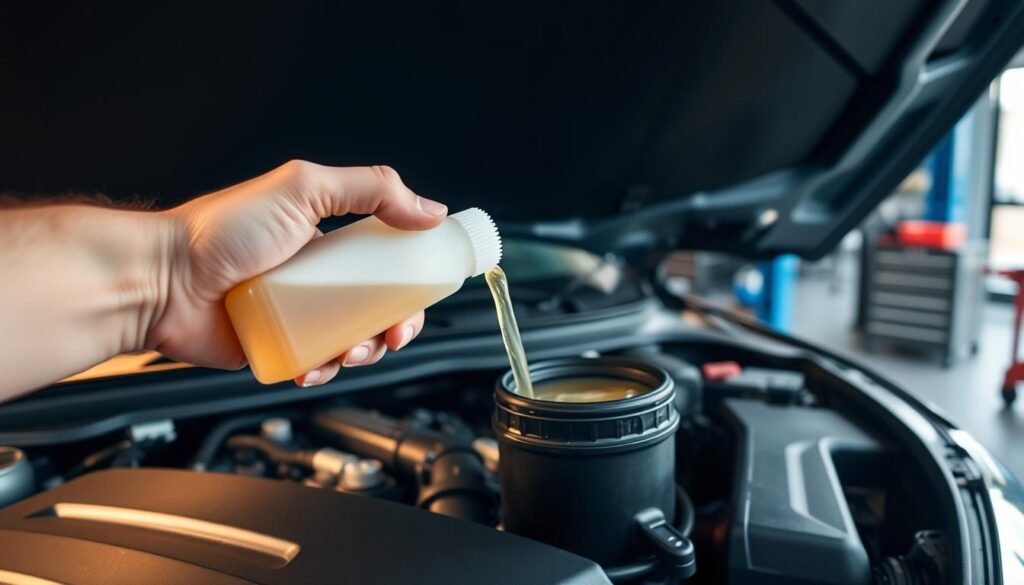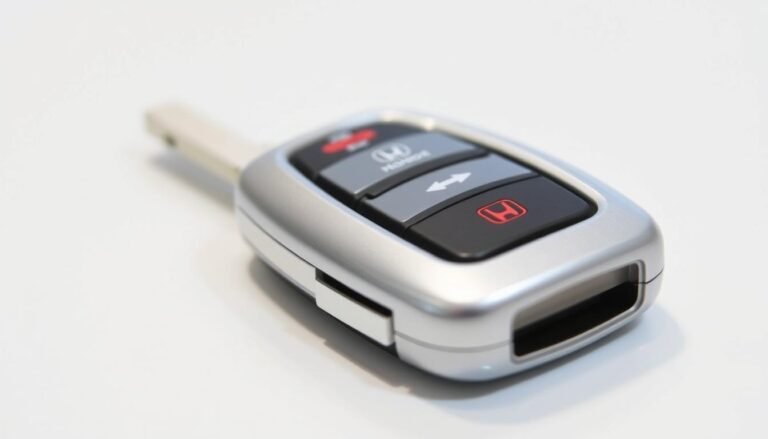Honda Transmission Fluid Change Better 7 Guide
Wondering how to change Honda transmission fluid? It’s easy and helps your car run well. This guide teaches you all you need for replacing Honda’s transmission fluid.
You’ll know when it’s time to change the fluid and the tools required. Keeping your transmission fluid clean is key for your Honda’s health.
It makes shifting gears smooth and prevents damage inside. This guide will give you the confidence to do this important task yourself.
We’ll go over how often to change the fluid and signs that show it’s time. You’ll learn every step for a fluid change, including picking the right fluid.
Avoid common mistakes and keep your Honda in top shape. Let’s start!
What is Honda Transmission Fluid?
Transmission fluid is key to keeping your Honda’s transmission in top shape. It works as a lubricant, cooling agent, and hydraulic fluid.
This keeps all the moving parts running smoothly. It’s crucial to use the correct fluid to prevent problems like overheating, bad shifting, and serious transmission damage.
What is Transmission Fluid?
Transmission fluid is a special lubricant for both automatic and manual vehicles. It makes gear changes smooth.
It also reduces friction and heat in the transmission. Knowing about transmission fluid helps you choose the right one when it’s time to change it.
Importance of Quality Transmission Fluid
Using top-quality transmission fluid boosts your Honda’s transmission life and function. Low-quality fluids can cause bad gear shifts and even transmission breakdowns.
High-quality fluids give the best protection and performance. Pick fluids that match Honda’s standards to keep your system running well and avoid expensive fixes.
| Transmission Fluid Type | Benefits | Recommended Brands |
|---|---|---|
| Standard Fluid | Affordable, good for basic performance | Honda Genuine ATF, Valvoline |
| Synthetic Fluid | Better for extreme conditions, improved longevity | Mobil 1, Amsoil |
When To Change Your Honda Transmission Fluid?
Knowing the right time to change your Honda transmission fluid is key for your car’s health.
It usually depends on your car’s model and how you drive. By checking the transmission fluid regularly, you can spot any issues early.
Recommended Change Intervals
Honda suggests a transmission fluid change every 25,000 miles or every three years for CVTs.
Your owner’s manual will have the exact info for your car. But remember, hard driving conditions might mean you need changes more often.
Signs You Need A Fluid Change
There are some signs that show it’s time for a fluid change. Watch for:
- Dark or burnt-smelling fluid
- Difficulty shifting gears
- Unusual noises coming from the transmission
Check your transmission fluid often to catch any problems early. This can help stop bigger issues with your transmission later.

Tools Required For Honda Transmission Fluid Change
Before changing your Honda’s transmission fluid, make sure you have the right tools. The right equipment will make the process easier, safer, and more efficient.
Essential Tools For The Job
- Wrench set for removing bolts and fittings.
- Transmission fluid pump to refill the new fluid easily.
- Drain pan to collect the old fluid.
- Funnel for precise pouring of the new fluid.
- Torque wrench for accurate tightening of bolts to specifications.
Safety Equipment To Consider
- Gloves to protect your hands from harmful chemicals and fluids.
- Goggles to shield your eyes from spills and fumes.
- Old rags for quick clean-up of any mess during the job.
Step-by-Step Guide To Honda Transmission Fluid Change
Changing your Honda’s transmission fluid needs careful planning and precise steps for the best performance. Follow this guide for a successful fluid change.
Preparing Your Vehicle
Park your Honda on a flat surface to start. Warm up the engine for a few minutes; it helps the fluid flow out better.
Then, turn off the engine and use wheel chocks behind the rear wheels for extra safety.
Lift the front of your car with a hydraulic jack and make sure it’s stable on jack stands before you begin working.
Removing The Undertray
To get to the transmission drain plug, you need to take off the undertray. Unscrew it with a socket wrench. Make sure you’re careful not to hurt any parts of the car.
Draining Old Fluid
Now you can get to the drain plug, put a pan under it to catch the old fluid. Open the plug with a socket or wrench and let all the fluid out.
Keep an eye on the fluid’s amount for filling it correctly later. Check the old fluid for any bad signs, like metal bits, which could mean there’s a problem.
Refilling with New Fluid
After draining, put a new crush washer on the plug before screwing it back in. This helps avoid leaks. Tighten the plug correctly.
Then, fill the transmission with new fluid that’s right for your Honda. Be sure about the fluid type and its quality.
Once filled, turn on your engine and let it run for a bit. Shift through the gears to spread the new fluid evenly.

Follow these steps carefully, and you’ll know how to change your Honda’s transmission fluid. This helps keep your transmission in top shape.
How To Perform A Honda Transmission Fluid Flush?
Doing a Honda transmission fluid flush is key for your vehicle’s transmission to stay healthy. This process takes out the old fluid and dirt, making sure it runs smoothly.
It’s needed if the fluid looks bad or you skipped regular checks. A good flush will make your transmission last longer.
Why Consider A Fluid Flush?
Keeping up with transmission care, like a Honda transmission fluid flush, keeps your vehicle running well.
Dirt can build up and damage the fluid, which causes rough shifting and can harm your car.
By flushing, you remove these bad particles and fill it with clean fluid. This is especially needed for cars driven hard or with lots of miles.
Steps For A Complete Flush
Follow these steps for a successful Honda transmission fluid flush:
- Get what you need ready, like a pump, new transmission fluid, and hoses.
- Find the transmission cooler line. It helps fluid move between the transmission and the radiator.
- Detach the cooler line and fix a hose to it.
- Put the hose’s other end into a container to catch the old fluid.
- Turn on the engine and use the pump. This sends new fluid in while the old fluid flows out.
- Keep going until the fluid looks clean. This shows it’s all cleaned out.
- Put the cooler line back on tightly after the flush is done.
- Check the fluid levels to make sure everything is right. Turn on the engine and shift through the gears to test.

Honda Transmission Fluid Change: Common Mistakes To Avoid
When you replace your Honda’s transmission fluid, knowing common mistakes is key. This knowledge prevents time loss and vehicle damage.
Overfilling Issues
Overfilling the transmission fluid is a big mistake. Too much fluid increases pressure, which can harm seals and components.
Make sure to check the manufacturer’s guidelines for the right fluid level.
Using Incorrect Fluid Types
Choosing the wrong type of fluid, like engine oil, can hurt performance. Hondas need special oils designed for them.
Always check that the fluid matches your car’s needs for its best performance and life.

Best Transmission Fluid For Honda Vehicles
Choosing the right transmission fluid for your Honda is very important. It helps your car run smoothly. You should think about your car’s model, transmission type, and the weather.
Also, consider how you usually drive. Picking the best fluid keeps your car’s transmission working well for a long time.
Considerations When Choosing Fluid
- Compatibility: Ensure the fluid meets Honda specifications for your vehicle model.
- Driving Conditions: Consider high temperatures and heavy loads that may demand higher quality fluids.
- Synthetic vs. Conventional: Synthetic fluids typically provide better protection under extreme conditions.
Brands and Types Recommended by Experts
Experts often suggest certain brands for replacing Honda transmission fluid. Here are some top choices:
| Brand | Type | Recommendation |
|---|---|---|
| ENEOS | Synthetic | Great for tough conditions. |
| Honda Genuine | OEM | Made just for Honda cars. |
| Valvoline | Synthetic Blend | Good protection, fair price. |
Maintaining Your Honda Transmission
Regular care makes sure your Honda transmission lasts long and stays reliable. By doing a few easy things, you can avoid expensive fixes.
Checking the honda transmission fluid regularly is key. It helps you spot problems early.
Regular Checks For Fluid Levels
For your Honda’s transmission to work well, checking the transmission fluid often is essential.
Make sure your car is on a flat surface and the transmission is warm when you check it:
- Park your Honda on a flat surface.
- Warm up the engine and let the vehicle idle.
- Locate the transmission dipstick and remove it.
- Wipe it clean and reinsert to check fluid levels.
Low fluid levels can overheat and damage the transmission. Having regular honda transmission maintenance helps avoid these problems.
Preventive Measures For Longevity
Take steps to make your Honda transmission last longer:
- Follow the recommended fluid change intervals in your owner’s manual.
- Keep the transmission cooler clean to ensure efficient operation.
- Address any leaks quickly to prevent fluid loss.
- Monitor how your vehicle shifts and address any irregularities immediately.
These steps will maintain your Honda’s transmission in top shape and improve its life.
| Maintenance Task | Frequency |
|---|---|
| Transmission Fluid Check | Monthly |
| Fluid Change | Every 30,000 miles |
| Cooler Cleaning | Annually |
| System Inspection | Every 15,000 miles |
Honda Transmission Service: What To Expect?
Choosing professional honda transmission service gives you peace of mind. You’ll know experts are checking your car’s transmission health.
They perform a detailed inspection. This includes checking your transmission fluid and looking for any shifting problems.
Technicians use the latest tools to check every part of the transmission works well. They might suggest a honda transmission fluid flush or change.
This helps your car perform better and makes the transmission last longer. Here’s a quick look at what happens during the service:
- Fluid Quality Assessment: The technician checks your current transmission fluid for contamination or degradation.
- Diagnostics: Advanced tools help identify potential shifting issues or faults within the transmission system.
- Fluid Change or Flush: Based on the assessment, the technician may perform a fluid change or a complete fluid flush to remove any debris.
- Recommendations: After the inspection and service, you will receive recommendations on any further maintenance needed to keep your transmission running smoothly.
Conclusion
Keeping up with Honda transmission maintenance is key to your car’s long life and peak performance.
Changing the transmission fluid regularly boosts reliability and avoids expensive fixes later.
This guide has given you the tools to change your Honda’s transmission fluid correctly. Looking after your car’s transmission helps it run better.
It’s vital to check the fluid levels and stick to the recommended schedule for changes.
Doing this keeps your Honda reliable for lots of miles ahead. Learning about your vehicle’s transmission fluid is a smart move.
With the right knowledge, changing a Honda’s transmission fluid can be simple. It leads to a smoother ride and better fuel efficiency.
FAQs
Q: How often should I change my Honda transmission fluid?
A: Experts recommend changing your Honda’s transmission fluid every 25,000 miles or every 3 years. For Continuously Variable Transmissions (CVT), follow these intervals closely. Always double-check your owner’s manual for your car’s specific needs.
Q: What are the signs that my Honda needs a transmission fluid change?
A: If your transmission fluid looks dark or smells burnt, it’s a hint. Having trouble shifting gears or hearing odd noises from the transmission are also signs. These indicate it’s time for a fluid change.
Q: What tools do I need to perform a Honda transmission fluid change?
A: You’ll need a wrench set, a fluid pump, a drain pan, a funnel, and a torque wrench. Don’t forget safety gear like gloves and goggles for protection.
Q: How do I check the transmission fluid in my Honda?
A: Park your car on a level surface and make sure the transmission is warm. Use the dipstick to check the fluid level, if your car has one. Otherwise, see your owner’s manual for instructions on checking fluid levels.
Q: What is a Honda transmission fluid flush, and when should I perform one?
A: A fluid flush means completely removing the old fluid and dirt. It’s a good idea if your fluid is very dirty or if you’ve skipped maintenance sessions.
Q: What are the best transmission fluid options for my Honda?
A: Choose transmission fluids that Honda approves. Brands like ENEOS and OEM products are recommended. Synthetic fluids are best for high performance and protection.
Q: How can I avoid common mistakes when changing my Honda transmission fluid?
A: Don’t overfill the transmission or use the wrong fluid type. Always follow the guidelines for the right fluid level and type. This ensures your transmission works well.
Q: What can I expect from professional Honda transmission services?
A: Professional services offer a thorough inspection and check-up of your transmission’s health. They’ll look at fluid quality and find any shifting issues. You might get a fluid flush or change if it’s needed.







